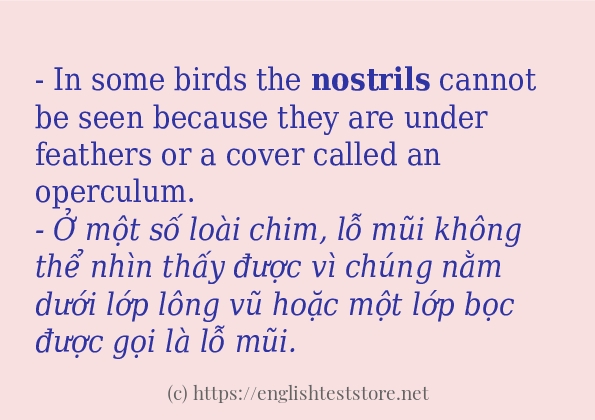Các cách sử dụng từ “nostrils”:
– In some birds the nostrils cannot be seen because they are under feathers or a cover called an operculum.
– Ở một số loài chim, lỗ mũi không thể nhìn thấy được vì chúng nằm dưới lớp lông vũ hoặc một lớp bọc được gọi là lỗ mũi.
– The opening of their nostrils has a hole through from one side of the beak to the other.
– Lỗ mũi của chúng có một lỗ thông từ mỏ bên này sang mỏ bên kia.
– A large hole near its nostrils may have been covered by a loose flap, which could be inflated to make sounds.
– Một lỗ lớn gần lỗ mũi của nó có thể đã bị che bởi một tấm đệm lỏng lẻo, có thể bị phồng lên để tạo ra âm thanh.
– While the infant is feeding, his or her nostrils may flare to breathe in air.
– Trong khi trẻ bú, lỗ mũi của trẻ có thể phập phồng để hít thở không khí.
– They have wide ventral scales, the tail is not as well-developed for swimming, and their nostrils are separated by scales.
– Chúng có vảy bụng rộng, đuôi không phát triển tốt để bơi, và các lỗ mũi của chúng được ngăn cách bởi vảy.
– This was probably to avoid water getting inside its nostrils when fishing.
– Điều này có lẽ là để tránh nước lọt vào lỗ mũi của nó khi câu cá.

Các câu ví dụ cách dùng từ “nostrils”:
- Sea snakes have special nostrils that can close when they go underwater and open when they come up to breathe, like the blowhole of a whale. - Rắn biển có lỗ mũi đặc biệt, có thể đóng lại khi chúng xuống nước và mở ra khi chúng lên để thở, giống như lỗ thổi của cá voi.
- Unlike other Hammerhead sharks the nostrils are closer to the centre of the cephalofoil than the ends. - Không giống như các loài cá mập Hammerhead khác, lỗ mũi gần với tâm của cephalofoil hơn phần cuối.
- Unlike other Hammerhead sharks the nostrils are closer to the centre of the cephalofoil than the ends. - Không giống như các loài cá mập Hammerhead khác, lỗ mũi gần với tâm của cephalofoil hơn phần cuối.
– Sea snakes have special nostrils that can close when they go underwater and open when they come up to breathe, like the blowhole of a whale.
– Rắn biển có lỗ mũi đặc biệt, có thể đóng lại khi chúng xuống nước và mở ra khi chúng lên để thở, giống như lỗ thổi của cá voi.
– Unlike other Hammerhead sharks the nostrils are closer to the centre of the cephalofoil than the ends.
– Không giống như các loài cá mập Hammerhead khác, lỗ mũi gần với tâm của cephalofoil hơn phần cuối.
– It is a little like the way humans cannot just take off their noses and throw them away, but they can put plugs in their nostrils and spoil their ability to smell things.
– Nó giống như cách con người không thể chỉ lấy mũi ra và vứt chúng đi, mà họ có thể nhét vào lỗ mũi và làm hỏng khả năng ngửi mọi thứ.
– The nostrils were on the top end of the snout.
– Lỗ mũi nằm ở đầu trên của mõm.
– The nostrils are placed inside the eyes.
– Lỗ mũi được đặt bên trong mắt.
– Their nostrils have evolved into slits which do not work properly.
– Lỗ mũi của họ đã phát triển thành các khe không hoạt động bình thường.
– In humans, the nasal cycle means that during the course of a day, the nostrils will switch over approximately every four hours or so, meaning that only one nostril is used at any one time.
– Ở người, chu kỳ mũi có nghĩa là trong suốt một ngày, các lỗ mũi sẽ chuyển đổi khoảng bốn giờ một lần, có nghĩa là chỉ có một lỗ mũi được sử dụng tại một thời điểm.
– New World monkeys have noses of flatter shape with nostrils facing to the side.
– Khỉ New World có mũi hình dạng phẳng hơn với lỗ mũi hướng sang một bên.
– Ventral scales are much smaller, the nostrils of the snakes are located dorsally and without scales between them.
– Vảy bụng nhỏ hơn nhiều, lỗ mũi của rắn nằm ở mặt lưng và không có vảy giữa chúng.
– Its nostrils were far back on the head, close to the eyes.
– Lỗ mũi của nó lùi xa trên đầu, gần với mắt.
– The nostrils and the mouth are at the far end of the beak.
– Lỗ mũi và miệng ở cuối mỏ.
– Their eyes and ears and nostrils are high on their heads, so they can easily be kept above water when the capybara is swimming.
– Mắt, tai và lỗ mũi của chúng cao trên đầu nên có thể dễ dàng giữ chúng ở trên mặt nước khi capybara đang bơi.
– The nostrils are the two breathing holes on the beak.
– Lỗ mũi là hai lỗ thở trên mỏ.
– The shark’s eyes and nostrils are placed on the ends of the cephalofoil.
– The shark’s eyes and nostrils are placed on the ends of the cephalofoil.
– There is speculation that this spike was attached to a flap of skin that covered the nostrils and could be blown up for displays and noise-making.
– Có suy đoán rằng mũi nhọn này được gắn vào một vạt da che lỗ mũi và có thể bị nổ tung để hiển thị và tạo ra tiếng ồn.
